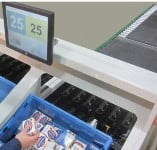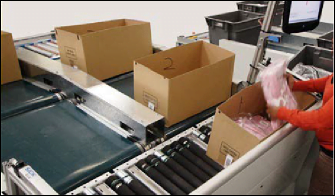How to Meet Distribution Operations Challenges in the Age of E-Commerce
By Thompson Brockmann Principal,
Tompkins International
Introduction
Since order fulfillment first became more automated for catalog sales back in the 1980s, its main justification has been to remove the travel time and distance by staff involved in processing orders. Then came online ordering and the rapid growth of e-commerce in the past decade, and the opportunity for automation of order fulfillment hit new heights.
Although much has changed since then with both customer expectations and technology, the objective and challenges are in many ways still similar. Eliminating walk and travel time has been met with limited success in the past; however, with the recent evolution of goods-to-person order fulfillment technology, your operation may be in a better position to incorporate these systems now than in the past.
“While goods-to-person order fulfillment systems are not new, the applications for these systems were never overly widespread in the past.”
There’s a whole new world of automation options out there – from robots roaming warehouses and distribution centers to highly automated conveyors and equipment that assist staff with faster fulfillment processes.
While goods-to-person order fulfillment systems are not new, the applications for these systems were never
overly widespread in the past due to limited benefits and functionality. In the right situations, justification for more common systems could be made (e.g., horizontal and vertical carousels or lifts), although many operations found it difficult to successfully maintain the system in order to reach the projected benefits.
Top Challenges in Goods-To-Person Fulfillment
What were the top issues typically encountered in goods-to-person fulfillment? And how do they apply to your operations today? Consider these challenges.
-
Space Requirements: While storage capacities were more efficient than static systems, the utilization of facilities’ full clear heights (the space from the floor to the ceiling) often required additional capital and space for mezzanines and order routing conveyance in a pick-and-pass process environment.
-
Fixed Throughput: The systems were often limited by the capacity of the picker, which meant the storage capacity needed to be designed so that demand from the system would not exceed throughput.
-
Lack of Staffing Flexibility: Systems either required constant staffing (regardless of volumes) or required operators to float between systems. This increased cycle time and created operational bottlenecks.
-
System Balancing: Product placement or “slotting” was a constant consideration to ensure that systems were being maximized but not overloading capacity during peaks. The systems provided little to no opportunity to increase system throughput for periods as needed.
-
Replenishment: The process of replenishment utilized the same station as picking, either reducing the pick rate or pushing replenishment to off-shift hours.
In the past, even with these limitations, goods-to-person order fulfillment systems made sense and provided a solid business case for straightforward order fulfillment applications. While these systems still have their applications, more often the requirements of today’s business customers and consumers push these systems beyond their capabilities.
In today’s environment of stock-keeping unit (SKU) proliferation, multichannel fulfillment centers, and enhanced data capture and manipulation requirements, goods-to-person technologies have been forced to evolve as well. They now incorporate improved controls and software, robotics with real-time reporting, and better data capture to provide a more flexible alternative at a competitive investment.
Rejuvenation of Goods-to-Person Systems Offers New Benefits
The traditional goods-to-person order fulfillment systems are often seen as relics of the past by many in the distribution field seeking to automate their operations. Compared to new systems that have debuted over the last few years, it is easy to understand this opinion.
Today’s systems offer considerably more compact design, faster operation, and provide a much higher level of flexibility. The new systems offer eight big advantages:
-
Operator Productivity: The main goal of all goods-to-person order fulfillment systems is to improve operator productivity. This was previously accomplished almost entirely through elimination of travel time. But today’s systems take this to the next step. They begin by better positioning both the product and the order container for easier, faster picking. Next, through the use of intelligent, real time decision-making by the system, product position is vastly improved and reduces cycle times. They better incorporate lights, displays, and voice direction to provide a more efficient method of communication and verification to and from the picker for improved order accuracy. Finally, today’s systems are faster and provide enhanced queuing to ensure operators are rarely idle between picks.
-
Ergonomics: As an added benefit to better positioning of the product and the order container, ergonomics for the picker are significantly enhanced. Both the pick from container and the pick to container can be placed at a height and angle that minimizes strain and movement while often completely eliminating handling of containers.
-
Space Reduction: Today’s systems are sleeker and more compact, and also minimize any dead space between storage locations. They are also are capable of improved utilization of clear height. Combining these design aspects significantly improve the storage cube capacity over the older systems. In addition, with the improved productivity, each aisle within a system can support more pick locations to increase overall capacity.
-

Source: Dematic
(www.dematic.com/rapidpick-system)Improved Operations: Depending on their design and operational requirements, goods-to-person order fulfillment systems still provide a definitive volume. However, with today’s higher throughput capacities, improved controls and material handling integration capabilities, these systems can be better leveraged to intelligently prioritize workloads, provide improved planning capabilities, and route orders efficiently through an entire operation.
-
Replenishment: Goods-to-person order fulfillment systems have evolved beyond the single operator station per module concept. Today’s systems often allow multiple stations per module or can extract the load from the system for conveyance to another location. They are no longer handcuffed to either perform picking or replenishment; both can be performed simultaneously with little impact on picking productivity.
-
Flexibility: Historically, one of the main disadvantages with goods-to-person order fulfillment systems has been their lack of flexibility. When treated as a standalone fulfillment, this has been true, but today’s systems can be better integrated into the entire operation so that picking capacity can be balanced with system throughput. When integrated into a hybrid solution, the pick stations are eliminated as system bottlenecks.
-
Scalability: Growth in storage capacity and throughput is no longer an obstruction with today’s systems. They now offer an easier path to increasing both with more scalable designs, often with minimal capital investment.
-
Security: Goods-to-person systems have always offered the added benefit of providing a secured environment for high value, small sized parts. The evolved system continues this trend and often improves the security functions as a part of the human safety interface.
Evaluation and Design Considerations to Ensure Payback
To meet the current dynamic distribution environment, goods-to-person order fulfillment systems needed to evolve dramatically over time. They have met this challenge and today offer significantly more benefits, improved functionality, and better flexibility; this extends their application opportunity across more industries and distribution channels.
However, to determine if they meet operational requirements and provide an acceptable justification, they need to be properly sized and planned into a functional design specification. The following list reviews design considerations that will minimize investment while maximizing benefits to ensure the payback is met as quickly as possible.
-
Product Characteristics: The size and types of product to be stored and picked are the first considerations to be reviewed. Begin by collecting item characteristics such as dimensions, weight, and quantity to be held, as well as any unique handling requirements, such as lot control separation. All information must be compiled to allow for an analysis to eventually determine the proper sizing and throughput requirements of a good- to-person order fulfillment system, as well as identify which items are best suited and provide the best payback.
-
Storage Capacity: Using the information collected, the cubic storage requirements for each item under consideration needs to be developed. Important elements to this analysis include the critical dimension of the items (longest of length, width, or height) and whether it is better to store them in their original carton, or if it is possible to place these into a uniform container or tray. If the original carton size varies, it is likely that the uniform, sectioned tray will provide a much better cube utilization. Once compiled, this is the information needed to develop the storage requirements.
-
Throughput Requirements: The next consideration is to determine peak throughput requirements. This is based on the maximum number of picks and replenishment that are required over an allowable cycle for completion. For instance, there may typically be a set number of replenishment or put-away moves required that can be completed over the course of the day, which allows for smoothing out this required rate. However, there may also be a large push of outbound orders in the afternoon that must be completed in a short time window. These factors must be considered when developing the overall throughput requirements.
-
System Sizing: The system sizing process can begin based on the storage and throughput requirements. The key is to balance storage capacity with the number of aisles or modules in order to meet the minimum requirements. All of the SKUs may not have profiles that are beneficial to goods-to-person order fulfillment systems; some may require too much cube given their limited activity, therefore not providing a justification. In these instances, hybrid designs that incorporate other order fulfillment technology may provide a better solution.
-
System Integration: A strategy must be developed that integrates the goods-to-person order fulfillment system into the entire operation. This should be completed regardless of the need for a standalone aisle or module, or if multiple aisles or modules are required. In the event of multiple modules, a strategy includes a decision to pick and pass the order containers between modules or to extract the pick from container to a central picking/replenishment station. The later strategy overcomes the module balancing and staffing issues of static workstations, but may require an additional investment in conveyance. If the pick from containers are captive to the system, additional staffing may be required to ensure that all modules are appropriately staffed.
-
Other considerations: Throughout the process, several other considerations must be kept in perspective to ensure a complete functional requirement design. These include available space and clear height, overall maintainability and access to key system components for repairs and preventive maintenance, as well as fire suppression design requirements. An equally important factor is including the contingency planning into the design process to ensure that disruptions to operations are minimized in the event of system down time.
Developing a functional system design for goods-to-person order fulfillment systems can be a complex undertaking, but proper planning results in a full understanding of the justification and a solid business case for their implementation.

Source: Dematic (http://www.dematic.com/pick-put-stations)
Review of Latest Automated Goods-to-Person Order Fulfillment Systems
Today’s automated goods-to-person order fulfillment systems have evolved into a variety of configurations and forms. They can use cases and cartons, and the load can be a pre- configured tote or tray. Although the traditional carousel and lift modules are still available, the focus will be on the automated systems in this article. These automated systems have been categorized by their technology:
-
Mini-Load ASRS (Automated Storage and Retrieval Systems): Mini-load ASRS were traditionally valued for their ability to reduce footprint versus providing an efficient method of bringing goods to an operator. However, manufacturers have continued to speed up their delivery cycles, which increase the number of loads being handled while lowering costs. Mini-load ASRS can be a competitive option, especially for heavier load requirements and dual usage as a high speed buffering system. Manufacturers of these systems include Daifuku Webb, Westfalia, and TGW.
-
Carousel ASRS: Carousel ASRS extend the functionality of the traditional horizontal carousel systems by adding a robotic extractor to the front end. By doing so, they are also capable of stacking multiple units to capture the full clear height of the facility. These systems can handle both cartons and containers, but require the load to be extracted and conveyed to another location for picking and replenishment. Manufacturers of these systems include System Logistics and Integrated Systems Design.
-
Shuttle-Based ASRS: By replacing the ASRS crane with multiple shuttles that operate simultaneously within an aisle, these systems have greatly increased the flexibility and throughput of the traditional small load ASRS systems. They are capable of handling either cartons or trays, and can be designed to be captive within the aisle or extract the load for processing elsewhere. Additional shuttles can be added based on the throughput requirements. Introduced just a few years ago, these systems have gained significant recent traction. A variety of manufacturers have introduced their products to the market including Dematic, Opex KNAPP, Symbotic, and Vanderlande.
-
Robotic Rover Systems: This technology uses a fleet of nomadic units on a two dimensional plane to shuffle and access unit loads to a processing station. These systems can either be top down or bottom up. Hatteland Logistics is a manufacturer of the top down, dense bin stack system called Auto Store. Kiva Systems provides a bottom up style system that moves the entire shelf to the processing station.
Summary and Conclusion
Goods-to-person order fulfillment systems have evolved over the years and will continue to change with customer expectations and developing markets. With picking labor requirement reductions up to 50%, the popularity of these systems is dramatically increasing. This is also due to improved space utilization and flexible designs.
“Customers now crave a flawless experience- the ability to order exactly what they want, when they want it, and how they want it, regardless of where they are located.”
The art and science is to properly assess, size, and design the system to ensure that benefits are maximized and the correct technology application is fit to the operation.
Customers now crave a flawless experience-the ability to order exactly what they want, when they want it, and how they want it, regardless of where they are located. To take full advantage of this, traditional distribution and fulfillment centers need to evolve into flexible, personalized distribution centers, fulfillment centers, and/or combination distribution and fulfillments centers. Learn more about this topic in Personalized Multichannel Logistics, a paper by Tompkins International.
How Tompkins International Can Help
For any distribution and fulfillment center, the major challenge revolves around developing and integrating processes and operations that are flexible enough to effectively meet all of the characteristics and requirements. The goal is to develop a layout and process design in which the facilities and material handling equipment are strongly leveraged and ensure that facility infrastructure and material handling equipment are efficiently used, as well as maximizing return on investment.
Developing a fulfillment center is a significant challenge for any organization. Tompkins has the experience and expertise to ensure your operations and resources are maximized. Our distribution operations consultants will develop the best-practice labor, equipment, and process strategies across all of your channels.
Our supply chain IT consultants develop the best systems approach to meet your corporate strategies. Our experts in inventory, transportation, and supply chain strategy develop the upstream and downstream capabilities to match the multichannel requirements. Finally, the Tompkins International material handling integration team will turn your seamless fulfillment plan into a reality by implementing a turn-key, fulfillment and distribution system.
We provide new solutions for operations improvement. Because high-performing supply chains are essential for revenue growth and strong operating margins, our goal is to enable client organizations to be more profitable and valuable, while also becoming more skilled, agile, and adaptive to leading practices.
Tompkins collaborates with our client teams to develop improved operations strategies, planning, and execution of all the Mega Processes (PLAN – BUY – MAKE – MOVE – DISTRIBUTE – SELL) of supply chains, both global and domestic, and from suppliers through to end customers. Tompkins’ service lines cover the supply chain strategies, processes, people, and technologies all the way through to facility designs, and material handling integrations.
We recognize that the rapidly changing marketplace requires new perspectives. Therefore, we deliver customized solutions to each client that pay back in benefits many times over financially and operationally, as well as in improved organizational capabilities. Our service promise is to work closely with clients, mitigating risks, and most importantly-doing the right things the right way.
For more information, contact info@tompkinsinc.comor visit our website www.tompkinsinc.com.


